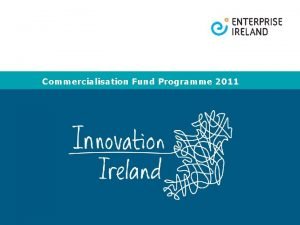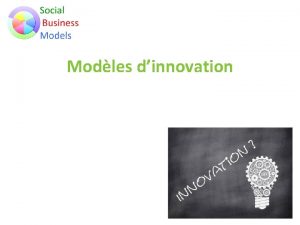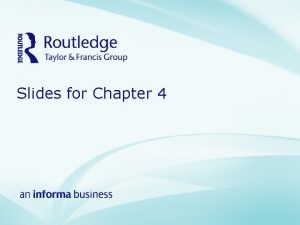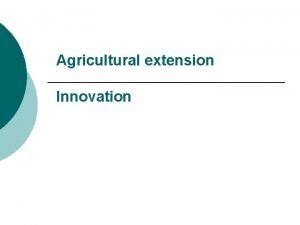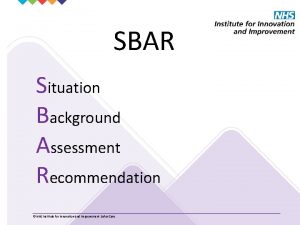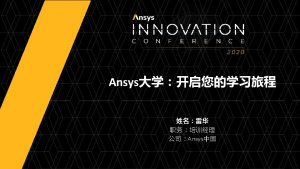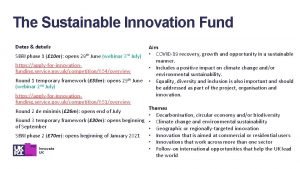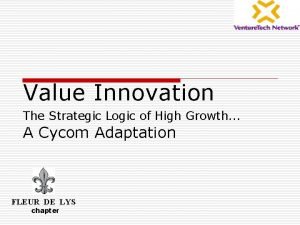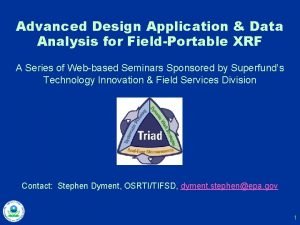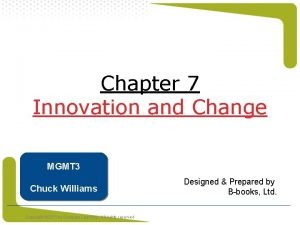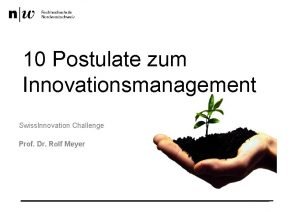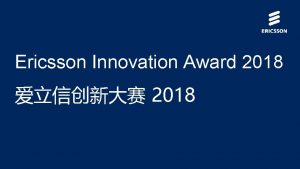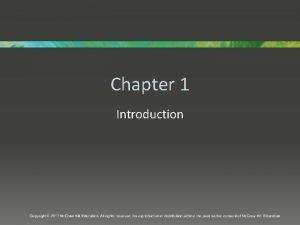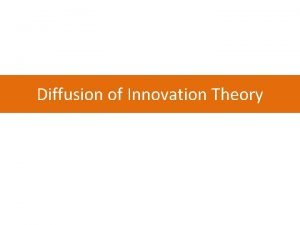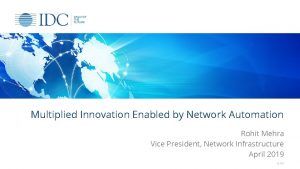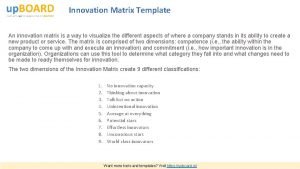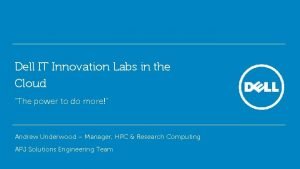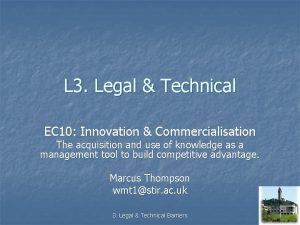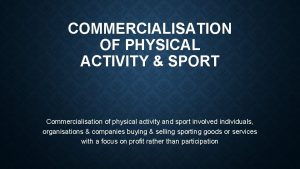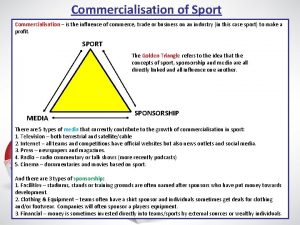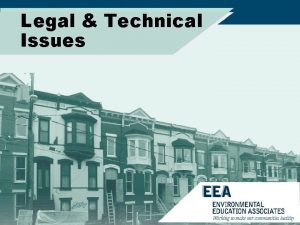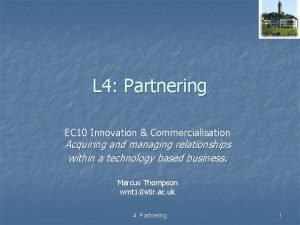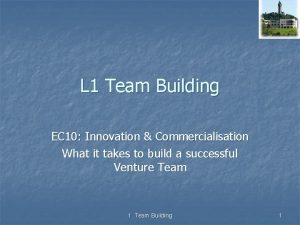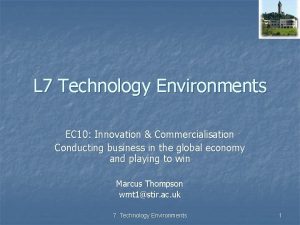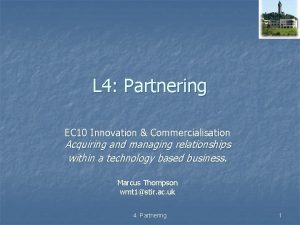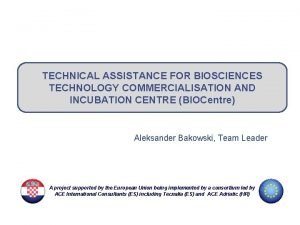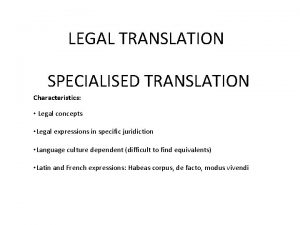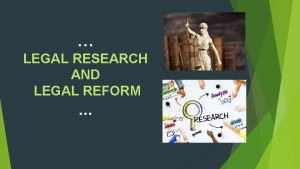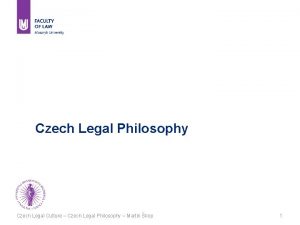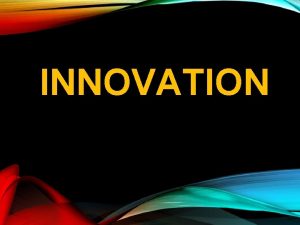L 3 Legal Technical EC 10 Innovation Commercialisation
































- Slides: 32

L 3. Legal & Technical EC 10: Innovation & Commercialisation The acquisition and use of knowledge as a management tool to build competitive advantage. Marcus Thompson wmt 1@stir. ac. uk 3. Legal & Technical Barriers 1

Legal & Technical Outline n Crossing the Chasm n Business Support n Intellectual Property n Product Development Strategies 3. Legal & Technical Barriers 2

1. Crossing the Chasm EC 10 Innovation & Commercialisation 3. Legal & Technical Barriers

Changing Industry Structures 4 Characteristics are: – – Scale Magnitude (to include status quo) Duration Strategic importance Benefits of managing change must occur at the human level. A leader must manage change at this level while still retaining the values, sense of identity and culture of the organisation 3. Legal & Technical Barriers 4

Moores Theory of Diffusion “The point of greatest peril in the development of a high-tech market lies in making the transition from an early market dominated by a few visionary customers to a mainstream market dominated by a large block of customers who are predominantly pragmatists in orientation. ” 3. Legal & Technical Barriers 5

Discontinuous Diffusion the rate of diffusion in the Technology Adoption Life Cycle curve is not continuous in high tech markets – the product's perceived advantage or benefit – riskiness of purchase – ease of product use - complexity of the product – immediacy of benefits – observability – trialability – price – extent of customers behavioural changes required – return on investment in the case of industrial products 3. Legal & Technical Barriers 6

Buying Theory & Innovation Innovators The enthusiasts who like technology for its own sake. Visionaries (or early adopters) Those who have the vision to adopt an emerging technology to an opportunity that is important to them. The Chasm Time gap in technology adoption, which is between the early adoptors and the pragmatists. Pragmatists (early majority) Early majority pragmatists are the solid citizens who do not like to take the risks of pioneering, but are ready to see the advantages of tested technologies. They are the beginning of a mass market Technology Life Cycle Model – adapted from Geoffrey Moore 1991, Crossing the Chasm 3. Legal & Technical Barriers 7

Diffusion Theory Everett Rogers ‘Diffusion of Innovations’ (1962) emerged in the 1960 s out of rural studies of innovation adoption A dominant model that has influenced thinking about the spread of new ideas, products and processes. The rural ‘extension’ programs are based on the diffusion model of knowledge transfer Diffusion Theory Is concerned with: – – the factors that affect the take up of an idea the factors affecting the spread of ideas or products and processes Diffusion is seen as information exchange, a communication process the notion of social communication networks through which information flows to reduce uncertainty 3. Legal & Technical Barriers 8

Information & Knowledge Five Stages 1. Knowledge 2. Persuasion 3. Decision 4. Implementation 5. Confirmation Three levels of Technology Transfer Knowledge Information exchange Use Commercialisation Intense information exchange Adapted from Rogers (1995, p. 163) 3. Legal & Technical Barriers 9

Diffusion Theory & R&D Direct collaborative research direct transfer to users spin-off companies tacit knowledge transfers readily Packaged papers, seminars, conferences, workshops, journals, licenses, patents. Consequences the knowledge has been produced and packaged so responsibility ends? adoption of an innovation is not a research problem? 3. Legal & Technical Barriers 10

‘the situated and intensely practical nature of the mechanisms involved in the transition of technology’ (Mc. Master, Vidgen & Wastell, 1997) 3. Legal & Technical Barriers 11

An Alternative Construct: Actor-networks from Studies in Science, Technology and Society (STS) Developed in the mid 1980 s by sociologists studying soci-technical interactions. Technology is a social construct, as such the social and the technical cannot be separated Based on notions of knowledge and power interrelationships as they relate to change, including innovation Defines and acknowledges the human and the non-human ‘Actors’ in the innovation process Defines three periods of network building with messy borders Emergence development stabilisation 3. Legal & Technical Barriers 12

2. Support for Innovation EC 10 Innovation & Commercialisation 3. Legal & Technical Barriers 13

New Technology Based Firms u "independently owned businesses established for not more than 25 years and based on the exploitation of an invention or technical innovation which implies substantial technological risks". Arthur D. Little, Consultancy 3. Legal & Technical Barriers 14

u u u innovative and technology-based firms are no more likely to fail than other small firms innovative or technology-based new and small firms are more likely to create employment than similar firms in the overall population, growth amongst innovative and technology based new and small firms tends to be concentrated in a few firms even amongst the fastest growing firms the absolute number of jobs created tends to be modest growth is seldom an objective of those firms. 3. Legal & Technical Barriers 15

Innovation: Visionaries V Pragmatists u Visionaries u – Adventurous – Early buy-in attitude – Think "big" – Independent of the "herd" – Spend big – First-use capability – Think Pragmatists are pedestrian Corporate Pragmatists – Prudent Wait-and-see – Manage expectations – Part of the "herd" – Spend to budget – Staying power – Think Visionaries are dangerous – Pragmatists don't trust visionaries as references. 3. Legal & Technical Barriers 16

Do not think about selling to. . u Pragmatists u or Late Majority The majority pragmatists, who represent about one-third of available customers, dislike discontinuous innovations and believe in tradition rather than progress. They buy high-technology products reluctantly and do not expect to like them. u Traditionalists or Laggards u do not engage with high technology products - except to block them. They perform the valuable service of pointing out regularly the discrepancies between the day-to-day reality of the product and the claims made for it. u At least until you have the organisation & team to do it! 3. Legal & Technical Barriers 17

Innovation Checklist u Does it create new value for customers? u Is asking price related to value for the customer – rather than to cost to produce? Reasonable speed to market is possible? Does it delivers benefits not product attributes? Simple and focused u u u – A response to unmet customer needs or problems? – – – Does one thing much better than anything else Satisfies one need Satisfies one group of customers Can it create first leadership advantage position in the market quickly? Not too clever nor too far ahead of market? Consistent with an organisation’s strength and not too diverse in terms of product? 3. Legal & Technical Barriers 18

3. Intellectual Property EC 10 Innovation & Commercialisation 3. Legal & Technical Barriers 19

Knowledge transfer & Commercialisation § Commercialisation is the process of taking these innovations and turning them into goods and services that add value in the marketplace (see Etzkowitz, Webster and Healey, Capitalizing Knowledge) § It takes entrepreneur(s) with the right combination of skills, abilities, resources, timing—and sometimes luck—to successfully commercialize technologies. 3. Legal & Technical Barriers 20

Commercialisation services provided by the Science Centre: § Incubation: Providing physical space and a range of supportive services to new companies. § Tech Transfer: Commercializing IP created in corporate research centers. § Business Planning: Drafting formal business plans. § Strategic Partnering: Facilitating the licensing of new technology or making the connections necessary to advance business goals. § Executive Training: Educating the decision makers in technology and life science companies. § Product Development/IP Strategy: Fine-tuning your product and service and developing a solid IP strategy. § Industry Education: Finding out about your business environment, including your competitors and industry leaders. 3. Legal & Technical Barriers 21

Tech Transfer & Science Parks § Management strategies used in United Kingdom – University led and funded strategy: Park established and developed and managed by a HEI on its own (this is the least common model). Examples include Cambridge, Heriot. Watt and Surrey. – Joint venture company strategy: Science Park run as a separate legal entity. This mechanism ensures a continuing positive role for the HEI and other investors in the joint venture company. Examples include Aston (Birmingham Technology Limited), Southampton (Chilworth Centre Limited) and Warwick (University of Warwick Science Park Limited). – Co-operative venture strategy: Partners work together within a flexible and informal framework. A local authority or development agency usually leads the development. Least input from the HEI. Most common strategy. Examples include Aberystwyth, Antrim, Durham and Stirling Science Parks. 3. Legal & Technical Barriers 22

Commercialisation Services § Scientific Product Review: Reviewing the scientific merits of your product or service. § Financial Planning: Building the financial infrastructure needed to support your business goals. § Grantwriting: Seeking grant-based research funding. § Access to capital: Providing the entrée to venture capitalists and investment bankers. § Investor Presentations: Preparing and refining successful presentations. § Market Positioning: Determining how your product fits within the marketplace. § Sales Strategy: Finding new markets for your products and services. 3. Legal & Technical Barriers 23

Clusters and Regional innovation § The concept of clusters developed to explain national or regional success – Innovation seldom takes place in isolation but is systemic. The cluster is a ‘reduced scale innovation system’ – Clusters as networks of production of strongly interdependent firms linked to each other in a value-adding production chain. – Clusters mostly also encompass strategic alliances with universities, research institutes, knowledge-intensive business services, bridging institutions (brokers, consultants) and customers. § § Communities of practice and networks of practice Knowledge communities e. g. Motorsport cluster 3. Legal & Technical Barriers 24

Creativity and Talent § Cluster success requires and encourages flow of talented individuals § Especially important in new economy, multimedia, creative industries etc § Work in the US on the geography of talent focuses on role of urban amenities § Association between creative employment and open, vibrant communities § Successful places are cosmopolitan, young people oriented, buzzing etc 3. Legal & Technical Barriers 25

Scotland Innovation § Scotland's innovation activity stems from the analysis set out in the Framework for Economic Development in Scotland (FEDS) and the Smart, Successful Scotland strategy for the enterprise networks. § Progress to date (2004) – On-stream projects 3. Legal & Technical Barriers 26

On Science Parks § “Faced with the magnitude of the task of innovation, appendixing to the science park the role of innovation ‘seedbed’ or regional development ‘growth pole’ may be an unrealistic expectation from a project that in many instances is not much more than a real-estate development. § Thus, if there is some disappointment in the fact that science parks are often not much more than high-tech ‘islands’ with minimal interactions both between themselves and with their neighbouring universities, it could be that hopes were pitched too high in the first place” (Felsenstein, 1994, p. 108). 3. Legal & Technical Barriers 27

4. Product Development Strategies EC 10 Innovation & Commercialisation 3. Legal & Technical Barriers 28

Continuous Development § According to Elfving et al. , (2003) ‘success in manufacturing requires continuous development and improvement of how products are developed and produced. § There is a need for new methods, tools and procedures to improve product development especially due to increased complexity and amount of relations between different actors. ’ 3. Legal & Technical Barriers 29

Levels Problem Definition § Macro Level § The Market, Usage, Organisational Structure, Environment, Social, Political § Meso Level § Competitiveness, Education, Research, Technology Policy § Micro Level § Technology, Product Development, Process Winkless, Cooney, 2005 3. Altran Legal Technologies, & Technical Barriers 30

The Product Life Cycle Market Introduction Market Growth Market Maturity Sales Decline Total Industry Sales + $0 Total Industry Profit Time – 3. Legal & Technical Barriers 31

Innovation Planning for Life Cycle Stages Introducing New Products Focus: Managing Mature Products Focus: Future Adaptation New Markets Dying Products Budget / Rate of Growth Persuasion / Less Profit Focus: New or Improve? Focus: New Strategies Focus: Phase Out 3. Legal & Technical Barriers 32
 Besigheidsplan
Besigheidsplan Incremental innovation vs disruptive innovation
Incremental innovation vs disruptive innovation Ib global contexts
Ib global contexts What is commercialisation in sport
What is commercialisation in sport The golden triangle commercialisation
The golden triangle commercialisation Commercialisation in sport definition
Commercialisation in sport definition Ei commercialisation fund
Ei commercialisation fund Fuzzy front end
Fuzzy front end National innovation centre for data
National innovation centre for data Produktlebenszyklus 4 phasen modell
Produktlebenszyklus 4 phasen modell Kenya climate innovation center
Kenya climate innovation center Innovation définition larousse
Innovation définition larousse Systematic innovation examples
Systematic innovation examples Innovation tournaments
Innovation tournaments Rdi research development innovation
Rdi research development innovation Sap innovation awards 2019
Sap innovation awards 2019 Extension innovation meaning
Extension innovation meaning Sbar nhs scotland template
Sbar nhs scotland template Valeo summer camp
Valeo summer camp Ansys conference 2020
Ansys conference 2020 Innovation fund
Innovation fund Value innovation the strategic logic of high growth
Value innovation the strategic logic of high growth Innovation field
Innovation field Compression approach to innovation
Compression approach to innovation Swiss innovation challenge
Swiss innovation challenge Ericsson innovation awards 2018
Ericsson innovation awards 2018 The importance of technology
The importance of technology Innovation diffusion theory
Innovation diffusion theory Automation
Automation Dynamically continuous innovation examples
Dynamically continuous innovation examples Eye punnett square
Eye punnett square Innovation matrix template
Innovation matrix template Dell innovation lab
Dell innovation lab






